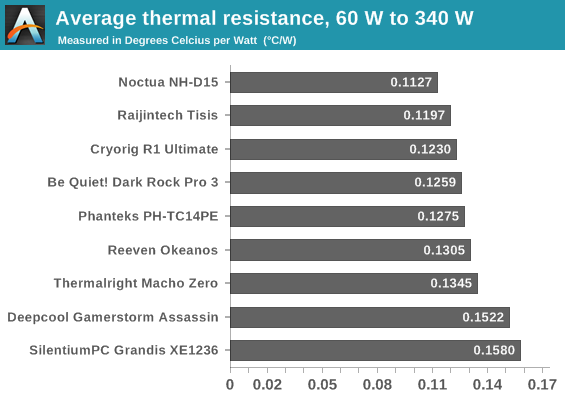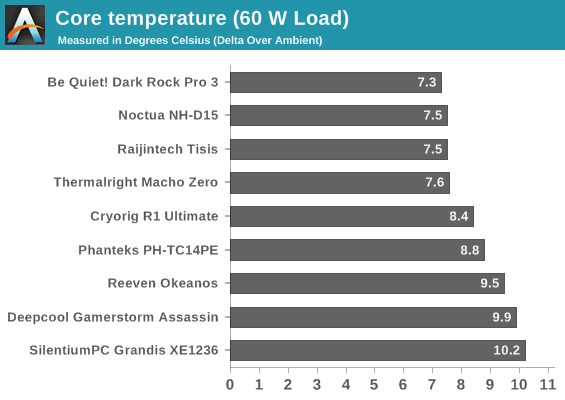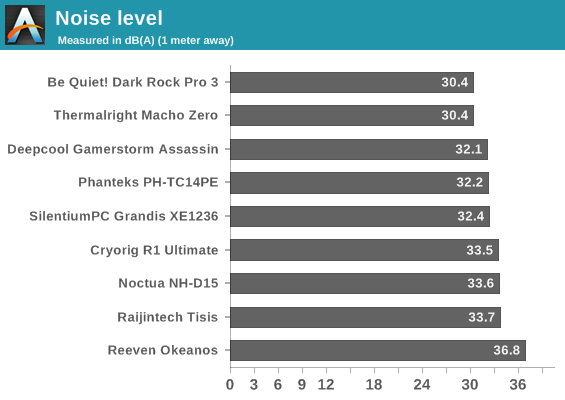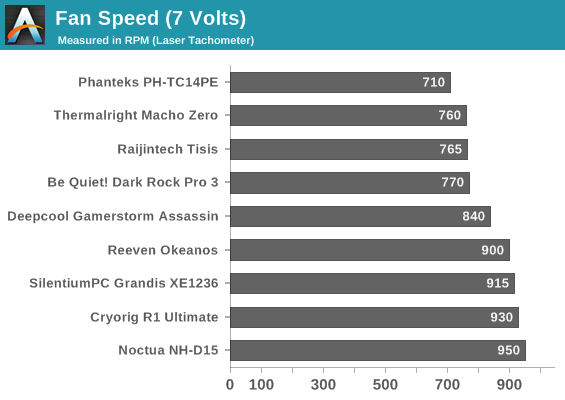Top Tier CPU Air Coolers Q3 2015: 9-Way Roundup Review
by E. Fylladitakis on July 6, 2015 8:00 AM ESTTesting results, low fan speed (7 Volts)


| Core Temperature, Constant Thermal Load |
|
|


*Note: When the cooler has two different fans, the fan speed of the faster fan is recorded.
**Note: Some of this review's PWM fans will not start if simply powered from a 7 Volts power source. Electronic supervision is required to start the fan and then reduce the voltage down to 7 Volts, or a PWM source.
Reducing the fan voltage down to 7 Volts shifts the thermal performance charts a little but brings all of the coolers down to virtually inaudible levels. The sole exception is the Okeanos, which definitely improved vastly in comparison to having its fans running at maximum speed, but remains audible.
With the Okeanos losing its advantage of brute force, the Noctua NH-D15 and the Raijintek Tisis now lead the thermal performance charts, closely followed by Cryorig's R1 Ultimate. The Phanteks PH-TC14PE is a bit more complicated, displaying that it can do much better at lower loads than with high loads, hinting that the airflow of the fans is simply not enough for this design to cope with very high loads. Be Quiet!'s Dark Rock Pro 3 is now showing thermal performance comparable to that of the aforementioned coolers, especially when the thermal load is low. Still, the Dark Rock Pro 3 technically loses its acoustics performance advantage. It may be dead-silent, with our equipment unable to record anything about the room's noise floor level, but the rest of the coolers are virtually inaudible as well.
The Thermalright Macho Zero is at advantage in these tests, as the cooler is optimized for low airflow situations. With the TY147A at a dead-quiet operating level, the Macho Zero offers very good thermal performance, especially at lower loads.
The two coolers with the worst overall thermal performance at this test were the Deepcool Assassin and the SilentiumPC Grandis. As far as the Grandis is concerned, the company will definitely not worry about their product not being able to compete directly with the best air coolers available, as it can still offer very good performance for the price of the cooler. The Assassin on the other hand fails to compete as well as it should, falling behind all other similarly sized products and even behind the Grandis during most of these tests.










135 Comments
View All Comments
mr_tawan - Monday, July 6, 2015 - link
Used to have 212+ once. Later I swapped out for a cheap closed-loop. Though the CPU temp is a few C lower, the closed-loop was much louder than the 212+ (due the the 'pump whine').Years later I upgrade the rig to a Core i5, which is not really that hot, and I'm not interested in overclocking anymore (being more mature I guess).
I find the 212 is pretty good for its price. It's a great entry-level cooler for those who want to upgrade. I also think that it could serve well as a baseline for the comparision.
zodiacfml - Monday, July 6, 2015 - link
I didn't know that overclocking enthusiast would prefer a lower performing heatsink instead of the best available. The reason is simple; CPUs consume less power throughout the years even with continuous but non synthetic workloads including gaming.Many years ago, I was a fan of watercooling then big-air heatsinks then not anymore. It is just not logical anymore as they are more expensive, larger, and cumbersome.
kmmatney - Monday, July 6, 2015 - link
To me, the whole point of overclocking is to get a better cpu than what you paid for. So overpaying for a heat sink doesn't make sense - the whole point is to get the best possible performance, while spending the least amount of money. At least that is what overclocking means to me, and I'm sure a lot of other people as well.Ian Cutress - Monday, July 6, 2015 - link
That's usually how most people start with overclocking. For others, it's getting the best performance regardless. That's why people still that the i7-K and push it, rather than a Pentium-K and tweak it.kmmatney - Monday, July 6, 2015 - link
I bought my Hyper 212 for $19.99 - a much bigger savings than $10. It does the job, and in the end my overclock was not limited by temperature, but by the CPU itself. A more expensive heatsink wouldn't gain me anything.aj654987 - Wednesday, July 8, 2015 - link
What are you even talking about. The 212 is $35 and half the cost of many of these heatsinks. Its been the gold standard for years, if you only get another 1 C out of a HSF that cost double then its not worth it.CummingsSM - Thursday, July 9, 2015 - link
Yep. You save $9.99 and then this happens: https://i.imgur.com/COC5qW9.jpg(In case someone is wondering: No, I didn't over-torque it, the bolt got caught in the back-plate and sheared under the power of a screwdriver lightly applied; And yes, that bolt is hollow; And yes, that is the mounting hardware from a CM 212 EVO; And yes, I'm done buying CM products.)
LittleLeo - Thursday, July 9, 2015 - link
Or a Beer and a bag of chipstabascosauz - Monday, July 6, 2015 - link
Are you kidding me? Intel's CPUs might be efficient compared to AMD's, but there is hardly a valid reason to dismiss the dual-tower crowd. Intel's CPUs are hotter than they have been in years, thermal performance having declined steadily since Sandy Bridge due to sh*ttier and sh*ttier TIM and other reasons.rickon66 - Monday, July 6, 2015 - link
Regarding the CM 212+/EVO -They did not want to show a $25 cooler that beat the expensive guys.